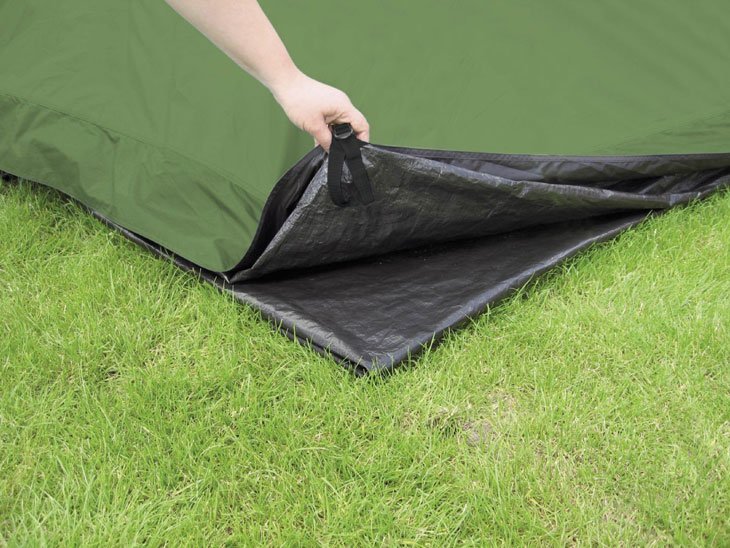If you’ve ever been out camping while a torrential downfall is happening outside your meager shelter, you’ll know that this scenario is very real. If you haven’t prepared your tent well, you’ll end up waking up to a very cold and miserable morning.
Yes, that’s something you don’t want and this is one of the biggest complaints campers have had throughout the years. That is until the real campers stepped up and showed a very simple trick to avoid too much moisture from seeping in.
And what’s that trick you ask? It’s pretty simple really. Just use a tent footprint.
Table of Contents
What Is A Tent Footprint?

A tent footprint is basically a light waterproof material that you place underneath your tent, right above the ground where it’s going to sit on. This prevents moisture from coming up through your tent’s contact with the ground.
There are a lot of types of tent footprints but the most important feature it should have is being waterproof. So, in essence you can actually use any material as long as it can help prevent water from seeping inside your tent from the ground.
Materials you can use are plastic, rubber, a vinyl tarp or a sheet of tyvek (lightweight material). This is the DIY route that most campers on a budget would probably go for.
How Much Does It Cost?

Most sporting and camping gear equipment stores provide tent footprints as add-on products you can purchase. Other tent makers have also started including tent footprints as part of their product offerings.
Now, you may choose to buy one off the shelf or you can simply create one for yourself. This is a good route to take if you’re good with your hands. All you simply need to do is get your hands on the basic materials and cut it to shape.
A basic tent footprint costs anywhere between: $10 to $30. If you want to make your own tent footprint, it’ll cost you considerably less than that amount.
Just make sure you cut your tent footprint according to the right size, so it doesn’t peek out of your tent when you lay it on the ground. As a simple rule of thumb, make sure your tent footprint is smaller by at least 2 inches all around when compared to your tent’s floor space. I will explain why later.
How do you use a tent footprint?
A tent footprint is a simple sheet that you basically lay over the ground before placing your tent on top of it. This means everything you basically do when pitching tent should be done before placing your tent footprint over it.
Choose a flat, slightly elevated area in the camping ground and place your tent footprint on top of it. Make sure you’ve cleared out all the debris from under it so you’ll be more comfortable inside your tent. This will also help you prevent stones and other sharp objects from ripping through the fabric of your tent and tent footprint.
Now pitch your tent and make sure it entirely covers your tent footprint by at least an inch or two around the perimeter. This prevents rain from collecting onto your tent footprint and depositing it between the material and your tent. This is the reason why your tent footprint should be slightly smaller than the base of your tent.
Finish pitching your tent and you’re basically done! Now you won’t have to worry about getting too much moisture inside your tent if it does rain.
Understanding how to use it properly can also be a good thing for you as it will maximize the usefulness of your tent footprint. Check out these videos to see how you can use your tent footprint.
Pros and cons of having a tent footprint

Since a tent footprint is an additional item you’re going to include in your camping gear, there’s bound to be a few pros and cons associated with it.
The most obvious advantage you can get out of having one is you can increase your chances of having a comfortable camping trip.
A disadvantage of having one is incorrectly placing one underneath your tent and not noticing that any portion of your tent footprint is peeking out and collecting water as it drops onto the material. This can easily be remedied by tucking it back into place or repositioning your entire tent, so the material is hidden from exposure.
You’re obviously going to be packing more weight on your back with the tent footprint in tow. This can easily be avoided if you choose lightweight materials to construct your tent footprint or buy professionally made ones because they’re engineered to be very light.
Lastly, there’s a cost involved whether you buy one off the shelf or make one yourself. You’re still going to have to buy the materials if you’re going the DIY route. Now, this is more of a mindset issue.
Having one increases your enjoyment during the camping trip regardless of whether your tent footprint is top of the line or a simple waterproof piece of material you made in your garage.
Conclusion
In conclusion, sacrificing a little more weight on your camping gear in exchange for comfort is actually a good trade off. Paying a small amount for one or coming up with a DIY tent footprint on your own at the cost of the basic materials is also a reasonable price to pay to have it as part of your gear.
Lastly, if you don’t want to end up shivering and miserable after a rainy night inside your tent, make sure you invest in a good tent footprint as part of your camping gear.
Here are some great finds on Amazon that you might want to check out:

